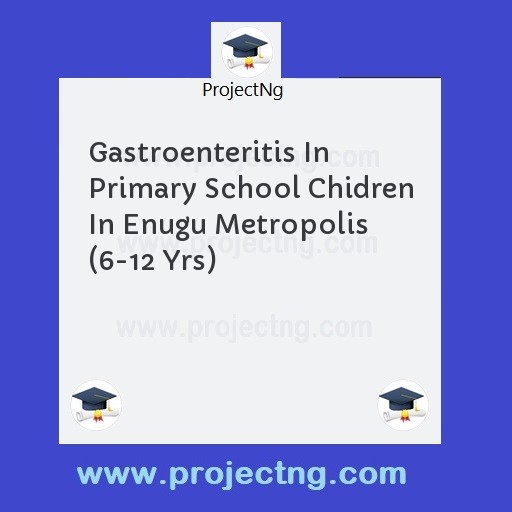Gastroenteritis In Primary School Chidren In Enugu Metropolis (6-12 Yrs)
Science Lab Technology Project Topics
Get the Complete Project Materials Now! »
GASTROENTERITIS IN PRIMARY SCHOOL CHIDREN IN ENUGU METROPOLIS (6-12 YRS)
ABSTRACT
A total of fifty faecal samples were collected form pupils in airport primary school Emene Enugu were used for the study. The duration of the investigation was between February August 2005. These samples were cultured and their causative organisms determined using macconkey agar, deocycholate citrate agar and an alkaline peptone water which was preparect according to manufacturers instruction .
The species of organisms isolated include; escherichia coil 8 (29 %) Klebsiella 5 (18%) Pseudomonas auroginosa 4 (14 %) shigella 3 (11%) proteus 2 (7%) staphylococcus SPP 2 (7%) respectively. These organism have a lot of health implication associated with gastroenteritis.
LIST OF TABLE
Table 1
Number of organism isolated with their percentage from school children
Table ii
Biochemical test for the identification of the bacterial isolates. (prescott et al 2005)
Table III
Pie chart representation of the organisms isolated form school children
Table IV
Histogram representation of the organisms isolated form school children
TABLE OF CONTENT
Title page
Certification
Dedication
Acknowledgement
Abstract
List of table
1.0 CHAPTER ONE INTRODUUCTION
1.1 Aims and objectives
1.2 Statement of problem
1.3 Hypothesis
1.4 Scope/ limitations of study
2.0 CHAPTER TWO LITERATURE REVIEW
2.1 Environmental factor
2.2 Bacterial diseases of the lower alimentary system
2.3 Sources of infection
3.0 CHAPTER THREE MATERIALS AND METHODS
3.1 material
3.2 Method
3.3 Method of culture
3.4 Plate reading
3.5 Biochemical reaction
CHAPTER FOUR RESULT
CHAPTER FIVE – Discussion and conclusion
CHAPTER SIX
Reference
Appendices
CHAPTER ONE
INTRODUCTION
Gastroenteritis is a disease condition due to the inflammation of the mucous of the stomach and intestine. Many microorganisms contaminating food and water can cause acute gastroenteritis. In most cases it runs its own course over several (days. However it can be a serious condition if the fluid loss is sever enough to cause dehydration. When food is the source of the pathogen the condition is often called food poisoning (Archeson 200)
Gastroenteritis can arise in two ways the microorganisms may actually produce a food borne infection, that is, they may first colonize the gastrointestinal tract and grow within it, then either invade host tissues or secrete exo- toxins (Johnson, 1999).
Alternatively the pathogens may secrete an exo- toxins that contaminates the food and is ingested by the host. This is some times reffered to as food intoxication because the toxins ingested and the presence of the living microorganisms is not required. Because theses toxins of the disrupt the functioning of intestinal mucosa they are called enterotoxins (Sanders and sanders 1997)
Most cases of gastroenteritis are due to viral infection about a half are caused by the rotavirus, first discovered and described at the royal children’s Hospital university of Melbourne in the early 1970 various other virus may cause the same symptoms as well as bacteria like campylobacter protozoa and helminthes. In most cases the precise infective agent is not identified. It is only when symptoms are persisting that stools are sent for microscopy and culture in the laboratory (Nachamkin 1992).
On a global scale gastroenteritis is a massive health problem. About 5 million people die each year, mainly young children in underdevloped countries most deaths are due to dehgdration, in adequate fluid replacement and cirulatory collapse. In Australia, Asia, African and South America an occasional fatality still occurs with gastroenteritis again mainly due to complication of sever dehydration A rotavirus vaccine has been developed in Australia and may eventually have extensive world wide application (Prescott et al 2005).
The main symptoms of gastroenteritis are vomiting diarliea and cramping abdominal pain. Sometimes of fever may also be present. In more severe cases,
Be the First to Share On Social

Enjoying our content?
Don't miss out on new videos! Subscribe to our YouTube channel for more awesome content.
Subscribe Now!













